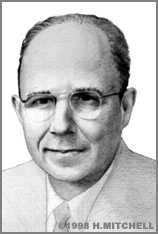Harold Edgerton
If ever an inventor left vivid, visual evidence of his achievements, it is Harold E. "Doc" Edgerton, who created some of the most memorable photographs of all time. In addition, Edgerton was an educator, engineer, and explorer.
Born in 1903 in Fremont, Nebraska, Edgerton grew up in nearby Aurora, where as a teenager, he learned photography from an uncle and built himself a darkroom in his home. Summer work at Nebraska Power & Light sparked his interest in the generation of electricity, and so he chose to study electrical engineering at the University of Nebraska at Lincoln, where he earned his BS in 1925.
After beginning graduate school at the Massachusetts Institute of Technology (MIT) in 1926, where he earned an SM (1927) and DSc (1931), Edgerton began working with the stroboscope. As many people are aware, a stroboscope generates brief, repeated bursts of light, which allow an observer to quickly view moving objects in a series of static, as-if frozen images, rather than a single continuous blur. By synchronizing strobe flashes with the motion being examined (for example, the spinning of engine rotors), then taking a series of photos through an open shutter at the rate of many flashes per second, Edgerton invented ultra-high-speed and stop-action photography in 1931.
Before long, Edgerton's astonishing photographs of everyday events won him acclaim around the world. His "Coronet" milk drop photo was featured in the New York Museum of Modern Art's first photography exhibit in 1937. In time, Edgerton would capture images of athletes competing (1938), hummingbirds hovering (1953), bullets bursting balloons (1959), and blood coursing through capillaries (1964).
At a less aesthetic level, Edgerton had not only paved the way for the modern electronic flash, he had given physicists a new means of analyzing the dynamics of fluids, air currents, and engines. The U.S. Army also saw the practical side of Edgerton's work. During World War II, Edgerton was commissioned to develop a superpowered flash for aerial photography. Edgerton's system allowed airplanes to do nocturnal reconnaissance, including the otherwise impossible documentation of Axis troop movements under the cover of darkness in the weeks preceding D-Day in 1944.
After the War, Edgerton founded a company, EG&G Inc., with two former students, Kenneth Germeshausen and Herbert Grier (1947). Under contract with the Atomic Energy Commission, Edgerton and his colleagues designed timing and firing systems for atomic bomb testing and invented a camera that could photograph an atomic explosion from seven miles away in 1947. EG&G also developed high-powered strobe lights for commercial use in apparatus ranging from lighthouses to copying machines.
In 1953, Edgerton entered yet another realm of inventing when he began a longtime collaboration with fellow inventor Jacques-Yves Cousteau in underwater exploration. Edgerton performed the first-ever underwater time-lapse photography in 1968. He also invented various sonar devices, including the "thumper," which analyzed the rock of the sea bed (1960), and the "boomer," which gave a seismic profile of the sea floor (1961). Edgerton also located and explored numerous underwater ruins and shipwrecks between 1966 and 1985. In fact, the first detailed photographs of the Titanic were taken with a camera designed by him in 1987.
During the course of his career, Edgerton earned dozens of patents for his devices. He also won the U.S. Army's Medal of Freedom (1946), the National Medal of Science (1973), and induction into the National Inventors Hall of Fame (1986), among other honors, and wrote or co-wrote four books. All the while, Edgerton, who had joined the MIT faculty in 1927, was teaching and directing research. Long before his colleagues elected him Institute Professor in 1966, he was one of MIT's most popular teachers. His "Strobe Alley" lab was – as it remains – legendary. As the Boston Patent Law Association and Boston Museum of Science put it, when naming Edgerton their New England Inventor of the Year in 1982, "through his marvelous medium, he has captured and revealed new beauty and order in both nature and industry."
Doc Edgerton died of a heart attack in 1990. His legacy survives, however, not only at MIT's Edgerton Center labs and the MIT Museum, but at the George Eastman House, the Edgerton Explorit Center in Aurora, Nebraska, and in the myriad of websites devoted to him.
Photographs ("Self-Portrait with Balloon and Bullet, 1959" and "Milkdrop Coronet, 1957") courtesy of ® The Harold E. Edgerton 1992 Trust.
For a photo-filled profile of Edgerton from a current exhibit, see "Never Stop Learning: the Life and Legacy of Harold Edgerton," curated by Edgerton expert Joyce Bedi of the Smithsonian Institution's Lemelson Center.
For recent ultra-high-speed photos taken by students following in Edgerton's footsteps, see High Speed Imaging.
For an interactive introduction to Edgerton's life and work see, "Seeing the Unseen: The Life and Work of Harold Edgerton."


